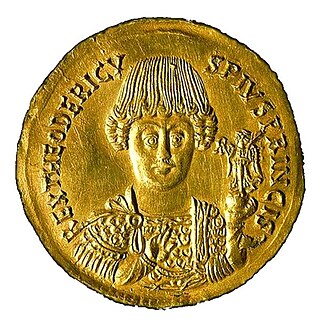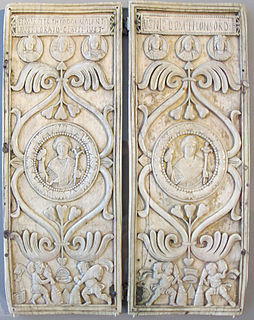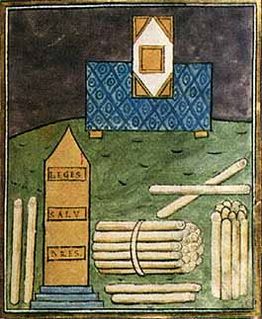
Constantinople was the capital city of the Roman Empire (330–395), of the Byzantine Empire, and also of the brief Crusader state known as the Latin Empire (1204–1261), until finally falling to the Ottoman Empire (1453–1923). It was reinaugurated in 324 from ancient Byzantium as the new capital of the Roman Empire by Emperor Constantine the Great, after whom it was named, and dedicated on 11 May 330. The city was located in what is now the European side and the core of modern Istanbul.

Justinian I, traditionally known as Justinian the Great and also Saint Justinian the Great in the Eastern Orthodox Church, was the Eastern Roman emperor from 527 to 565. During his reign with the help of his wife, Justinian sought to revive the empire's greatness and reconquer the lost western half of the historical Roman Empire. Justinian's rule constitutes a distinct epoch in the history of the Later Roman empire, and his reign is marked by the ambitious but only partly realized renovatio imperii, or "restoration of the Empire".

Justin I was the Eastern Roman Emperor from 518 to 527. He rose through the ranks of the army to become commander of the imperial guard. When Emperor Anastasius died he out-maneouvered his rivals and was elected as his successor, in spite of being almost 70 years old. His reign is significant for the founding of the Justinian dynasty that included his eminent nephew Justinian I and three succeeding emperors. His consort was Empress Euphemia.

Pope Pelagius I was Pope from 556 to his death in 561. He was the second pope of the Byzantine Papacy, and like his predecessor, a former apocrisiarius to Constantinople.

Leo I was Eastern Roman Emperor from 457 to 474. A native of Dacia Aureliana near historic Thrace, he was known as Leo the Thracian.

Justinian II, surnamed the Rhinotmetos or Rhinotmetus, was the last Byzantine Emperor of the Heraclian Dynasty, reigning from 685 to 695 and again from 705 to 711. Justinian II was an ambitious and passionate ruler who was keen to restore the Roman Empire to its former glories, but he responded poorly to any opposition to his will and lacked the finesse of his father, Constantine IV. Consequently, he generated enormous opposition to his reign, resulting in his deposition in 695 in a popular uprising, and he only returned to the throne in 705 with the help of a Bulgar and Slav army. His second reign was even more despotic than the first, and it too saw his eventual overthrow in 711, abandoned by his army who turned on him before killing him.

The Plague of Justinian was a pandemic that afflicted the Eastern Roman (Byzantine) Empire, especially its capital Constantinople, the Sasanian Empire, and port cities around the entire Mediterranean Sea. One of the deadliest plagues in history, the devastating pandemic resulted in the deaths of an estimated 25–50 million people in two centuries of recurrence, equivalent to 13–26% of the world's population at the time of the first outbreak. The plague's social and cultural impact during the period of Justinian has been compared to that of the similar Black Death that devastated Europe 600 years after the last outbreak of Justinian plague. Procopius, the principal Greek historian of the 6th century, viewed the pandemic as worldwide in scope.

The Dominate or late Roman Empire is the name sometimes given to the "despotic" later phase of imperial government, following the earlier period known as the "Principate", in the ancient Roman Empire. This phase is more often called the Tetrarchy at least until 313 when the empire was reunited.
Germanus was an East Roman (Byzantine) general, one of the leading commanders of Emperor Justinian I. Germanus was Emperor Justinian's cousin, and a member of the ruling dynasty. He held commands in Thrace, North Africa, and the East against Persia, and was slated to command the final Byzantine expedition against the Ostrogoths. Having married into the Gothic Amal royal line through his second wife Matasuntha and a distinguished service record, at the time of his sudden death, he was considered the probable heir to Emperor Justinian.

The Ostrogothic Kingdom, officially the Kingdom of Italy, was established by the Ostrogoths in Italy and neighbouring areas from 493 to 553.

The praefectus urbanus, also called praefectus urbi or urban prefect in English, was prefect of the city of Rome, and later also of Constantinople. The office originated under the Roman kings, continued during the Republic and Empire, and held high importance in late Antiquity. The office survived the collapse of the Western Roman Empire, and the last urban prefect of Rome, named Iohannes, is attested in 599. In the East, in Constantinople, the office survived until the 13th century.
Artabanes was an East Roman (Byzantine) general of Armenian origin who served under Justinian I. Initially a rebel against Byzantine authority, he fled to the Sassanid Persians but soon returned to Byzantine allegiance. He served in Africa, where he won great fame by killing the rebel general Guntharic and restoring the province to imperial allegiance. He became engaged to Justinian's niece Praejecta, but did not eventually marry her due to the opposition of the Empress Theodora. Recalled to Constantinople, he became involved in a failed conspiracy against Justinian in 548/549, but was not severely punished after its revelation. He was soon pardoned and sent to Italy to fight in the Gothic War, where he participated in the decisive Byzantine victory at Casilinum.
Peter the Patrician was a senior East Roman or Byzantine official, diplomat, and historian. A well-educated and successful lawyer, he was repeatedly sent as envoy to Ostrogothic Italy in the prelude to the Gothic War of 535–554. Despite his diplomatic skill, he was not able to avert war, and was imprisoned by the Goths in Ravenna for a few years. Upon his release, he was appointed to the post of magister officiorum, head of the imperial secretariat, which he held for an unparalleled 26 years. In this capacity, he was one of the leading ministers of Emperor Justinian I, playing an important role in the Byzantine emperor's religious policies and the relations with Sassanid Persia; most notably he led the negotiations for the peace agreement of 562 that ended the 20-year-long Lazic War. His historical writings survive only in fragments, but provide unique source material on early Byzantine ceremonies and diplomatic issues between Byzantium and the Sassanids.

Flavius Mar(cianus?) Petrus Theodorus Valentinus Rusticius Boraides Germanus Iustinus, simply and commonly known as Justin, was an East Roman (Byzantine) aristocrat and general. A member of the Justinian Dynasty and nephew of Emperor Justinian I, he was appointed as one of the last Roman consuls in 540, before going on to assume senior military commands in the Balkans and in Lazica. He fought against the Slavs, the Sassanid Persians and supervised the Byzantine Empire's first contacts with the Avars. At the time of Justinian's death, he was seen as a probable successor, but was beaten to the throne by his cousin, Justin II, who exiled him to Egypt, where he was murdered.
Justinian was an East Roman (Byzantine) aristocrat and general, and a member of the ruling Justinian dynasty. As a soldier, he had a distinguished career in the Balkans and in the East against Sassanid Persia. In his later years, he plotted unsuccessfully against regent and later emperor Tiberius II.
Vitalian was a general of the East Roman (Byzantine) Empire. A native of Moesia in the northern Balkans, and probably of mixed Roman an Gothic or Scythian barbarian descent, he followed his father into the imperial army, and by 513 had become a senior commander in Thrace.

The quaestor sacri palatii, in English: Quaestor of the Sacred Palace, was the senior legal authority in the late Roman Empire and early Byzantium, responsible for drafting laws. In the later Byzantine Empire, the office of the quaestor was altered and it became a senior judicial official for the imperial capital, Constantinople. The post survived until the 14th century, albeit only as an honorary title.
Tzath II was King of Lazica as a Byzantine client from 556 to an unknown date.
Flavius Domnicus was a Byzantine military officer and patrikios, active in the reign of Emperor Justinian I. He should not be confused with his contemporary Domnicus, Praetorian prefect of Illyricum.
Arsaces was a Byzantine conspirator against Emperor Justinian I. He was the instigator of Artabanes's conspiracy. The main source about him is Procopius.















